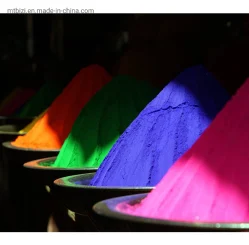Some common types of metallic pigments
2023-12-04
Metallic pigments are colorants that impart a metallic or pearlescent effect to coatings, paints, plastics, and other materials. Unlike traditional pigments, metallic pigments do not absorb light but instead manipulate light through reflection, refraction, and interference. This results in a range of metallic or iridescent appearances. These pigments are often used to enhance aesthetics, create special effects, and provide a unique visual appeal. Here are some common types of metallic pigments:
1. Aluminum Powder:
- Effect: Silver Metallic
- Properties: Aluminum powder is finely ground aluminum that imparts a silver metallic appearance. It is used in a variety of applications, including automotive coatings, printing inks, and decorative paints.
2. Bronze Powder:
- Effect: Bronze Metallic
- Properties: Bronze powder is made from finely ground bronze alloy. It provides a warm, bronze metallic appearance and is used in artistic paints, coatings, and decorative applications.
3. Copper Powder:
- Effect: Copper Metallic
- Properties: Copper powder imparts a rich copper metallic appearance. It is used in applications where a warm, reddish-brown metallic effect is desired.
4. Zinc Powder:
- Effect: Zinc Metallic
- Properties: Zinc powder provides a metallic appearance similar to that of galvanized steel. It is used in industrial coatings, protective coatings, and corrosion-resistant applications.
5. Pearlescent Pigments (Mica-Based):
- Effect: Pearlescent/Iridescent
- Properties: Pearlescent pigments are often based on mica flakes coated with metal oxides or other materials. They create a pearlescent or iridescent effect, changing color based on the viewing angle. These pigments are widely used in cosmetics, automotive finishes, and plastics.
6. Interference Pigments:
- Effect: Color-Shifting/Iridescent
- Properties: Interference pigments are designed to produce color shifts when viewed from different angles. They create dynamic and iridescent effects, often used in automotive coatings, specialty inks, and cosmetics.
7. Metallic Flakes (Various Metals):
- Effect: Varied Metallic Finishes
- Properties: Metallic flakes can be made from various metals, including aluminum, copper, or alloys. These flakes create a textured metallic appearance and are used in automotive paints, industrial coatings, and crafts.
8. Gold Leaf and Gold Powder:
- Effect: Gold Metallic
- Properties: Gold leaf, made from thin sheets of gold, or gold powder can be used to achieve a rich gold metallic appearance. They are used in artistic applications, gilding, and decorative finishes.
9. Silver Leaf and Silver Powder:
- Effect: Silver Metallic
- Properties: Similar to gold leaf, silver leaf or silver powder provides a metallic silver appearance. They are used in various artistic and decorative applications.
10. Metallic Ink and Paint Additives:
- Effect: Metallic Sheen
- Properties: Metallic additives, often in the form of particles or flakes, can be added to inks and paints to create a metallic sheen. These additives are used in printing inks, packaging, and artistic paints.
Metallic pigments are valued for their ability to enhance the visual appeal of products, providing effects ranging from subtle metallic luster to bold and dynamic iridescence. The choice of metallic pigment depends on the desired effect, the application requirements, and the overall aesthetic goals of the final product.



